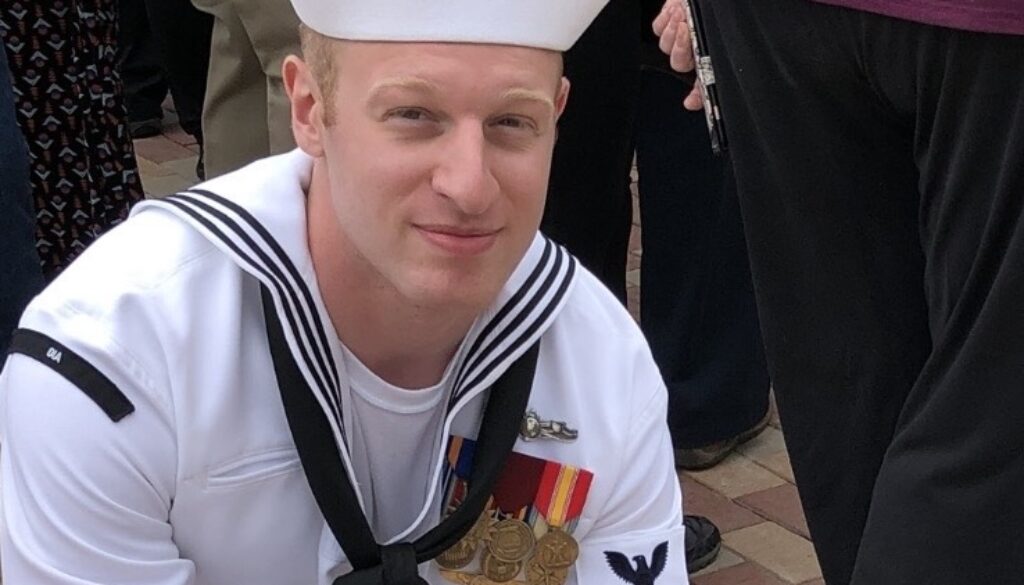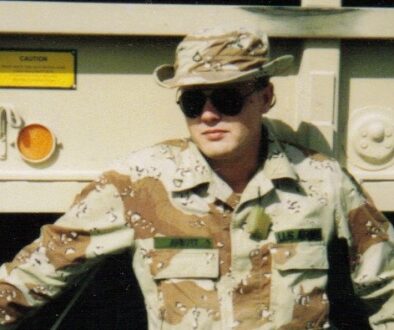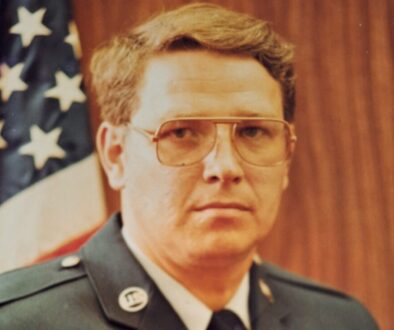CTT2 Thomas Elling, U.S. Navy – Deploying to Two Theaters as a Navy Cryptologic Technician
The active duty and Selected Reserve Navy consists of almost 394,000 officers and enlisted sailors all doing their part to make the U.S. Navy the most powerful maritime force the world has ever seen. Most of the active and reserve sailors have traditional jobs, manning the ships, submarines, and aircraft that patrol on, under, and above the world’s oceans 24 hours a day, 7 days a week, 365 days a year. Others, like Cryptologic Technician Technical Second Class (CTT2) Thomas Elling, provide niche warfare services critical to the success of the more traditional operating forces. Whether part of the active or reserve forces, they are highly trained, technologically advanced, and must always be ready to fill high-priority billets. Thomas Elling made two critical deployments, providing signals intelligence to U.S. Navy and Special Operations forces, helping project U.S. military power and resolve abroad. This is his story.
Tom was born in 1995 in Smithtown, a small town of about 116,000 people located on the north shore of Long Island, New York. When he was still a toddler, his parents moved to Tonawanda, New York, a suburb of Buffalo. His father was a district manager for the Buffalo News. The paper was a family affair, as Tom’s mother had a Buffalo News paper route, delivering papers to homes early in the morning. Once she completed her route each day, she worked a full-time job at a local hospital. This grueling work schedule allowed Tom’s mom and dad to raise Tom and his two younger sisters in a typical middle-class Buffalo suburban environment.
Tom began his high school studies at St. Joseph’s Collegiate Institute, an all-boys Catholic school in nearby Kenmore, New York. He enjoyed the school because it expanded his horizons beyond Tonawanda by introducing him to boys from all around the area. Halfway through his sophomore year, he transferred to a public school, Kenmore West Senior High School. He played hockey all through his first three years, not only for both his high schools, but also on a traveling team and during the summer on his neighborhood’s streets. He also enjoyed playing guitar and an occasional round of golf, and did everything he could to earn spending money, including working at restaurants as a dishwasher, working in the meat department at a local grocery store and in a department store, and cutting lawns.
Things changed during Tom’s senior year when he began to take classes at Erie Community College in addition to his high school courses. The added course load meant he could no longer play hockey, but it allowed him to graduate from Kenmore West Senior High School a semester early in January 2013. He continued taking classes at Erie Community College during the spring of 2013 and then enrolled at the State University of New York (SUNY) at Fredonia beginning in the fall of 2013. He had a great time at SUNY Fredonia but his grades did not, so at the end of the spring semester the university suggested he try something else for a while.
Knowing his spring semester would be his last, Tom began searching for options. He had always admired President John F. Kennedy, so he considered the Peace Corps and the military. When he asked his mother for advice, she agreed the military was a good option. The guys he lived with at college reinforced this choice as both were Iraq War veterans. They suggested Tom join the Army Reserve so he could earn and take advantage of the GI Bill to pay for his college education whenever that might resume.
The transition from SUNY Fredonia back to Tonawanda proved difficult. Tom’s parents had recently split up, so Tom had nowhere to go. He ended up sleeping on his grandparent’s sofa for the summer as he finalized his plans. In late July or early August 2014, he took the plunge. He initially visited a Marine recruiter and then an Army recruiter, but quickly recognized those were not the services for him. His next stop was a Navy recruiter and they clicked. Tom had also been in touch with a high school friend who’d joined the Navy and become a Cryptologic Technician (CT), which sounded interesting to Tom. And, because Tom scored high enough on the Armed Services Vocational Aptitude Battery (ASVAB), the Navy recruiter could promise Tom a job as a CT once he completed the necessary training pipeline.
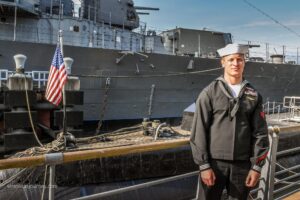
Convinced he was on the right path, Tom signed up for the Navy Reserves on August 31, 2014. Instead of reporting for duty immediately, though, he enlisted in the Delayed Entry Program, which gave him a start date at the end of March 2015. In the interim, he attended meetings once each month with other recruits in the Delayed Entry Program. At the one-to-two-hour meetings, they heard speakers, did some drills, and learned information to help ease their transition from civilians to sailors at boot camp.
When the end of March 2015 finally arrived, Tom was ready. He reported to the Buffalo Military Entrance Processing Station (MEPS) and took the oath of enlistment, making his commitment to the Navy official. Then, after spending the night at a local hotel with the recruits from all four services awaiting transportation to their initial training, Tom and another Navy recruit boarded a plane at Buffalo International Airport heading for Chicago. From there they went to the Great Lakes Naval Training Center just north of Chicago to begin boot camp.
Tom found boot camp relatively easy. He knew what he had to do and was both physically and mentally prepared for the training. He also wanted to do anything that could help him make rank as fast as possible, so he volunteered for and became his company’s Assistant Recruit Chief Petty Officer (AROC). As the AROC, he was responsible for assisting the Recruit Chief Petty Officer in maintaining the company and for calling the cadence when the company marched from place to place.
The days at boot camp were long but the weeks were short. Tom spent a lot of time mopping floors and doing pushups, as did all the recruits. Overall, though, he found it a positive experience. He got to eat as much as he wanted and wrote letters home once a week, which was more than he expected. On the downside, it was early spring in Chicago, so the weather brought lots of rain and wind and a damp piercing cold unlike what he was used to in Buffalo.
Graduation finally arrived on May 31, 2015, and Tom’s mother and two sisters flew to Chicago to attend the ceremony. Afterwards, Tom headed for his follow-on training, Cryptologic Technician Technical (CTT) “A” school, in Pensacola, Florida. As a CTT, Tom would be responsible for operating systems that collected signals intelligence, controlling systems capable of jamming adversary radars and weapons systems, and providing technical and tactical guidance to U.S. forces based upon signals intelligence. CTT “A” school began Tom’s training in this highly specialized field, focusing mainly on the fundamentals of radar.
Although Tom had to learn a lot of new information at “A” school, including some complex mathematics, going to school in Pensacola had its perks. Most important, once his class qualified for Phase II liberty, they could go off base to explore the city’s restaurants and bars and area beaches. And, unlike the late spring weather in Chicago, Pensacola’s weather remained beautiful for Tom’s entire stay.
Tom graduated from the seventeen-week CTT “A” school in October 2015 and returned to Buffalo for duty. Since he had enlisted in the Navy Reserve rather than the active duty Navy, he reported to the Navy Operational Support Center (NOSC), which provides administrative support to Navy reservists. He began drilling there one weekend each month, but since the NOSC didn’t have anything for CTTs to do, Tom spent the bulk of his time each drill period doing odd jobs like sweeping and maintaining the facility. Finally, after three or four months of marking time, the Defense Intelligence Agency (DIA) saw Tom was available for orders and recruited him for an assignment with an intelligence unit in Rome, New York. That meant traveling to Rome, about 190 miles away, for each month’s drill weekend.
Tom’s assignment at DIA turned out to be similar to his situation at the NOSC because there was nothing for him to do but odd jobs and reviewing PowerPoint presentations. Bored, Tom started to pursue options for obtaining active duty orders so he could put his CTT training into practice. This resulted in him being assigned in 2016 to the next level of CTT training, “C” school. The training, which was also located in Pensacola, took Tom twenty-six weeks to complete. He also promoted to Petty Officer Second Class (E-5), which when combined with his CTT job classification or “rate”, is abbreviated as CTT2.
In October 2016, Tom finally found what he was looking for when he received one-year active duty orders as an individual augmentee to a Joint Special Operations Command (JSOC) located at Fort Bragg, North Carolina. As the JSOC was primarily comprised of reservists from all four services who joined the unit as individual augmentees, the newly formed team trained together for several months before deploying to Djibouti on the Horn of Africa for nine months.
Tom and the rest of the JSOC initially departed for their deployment on a U.S. Navy “rotator” flight originating in Baltimore, Maryland, and eventually arriving in Addis Ababa, Ethiopia. From there they caught an Ethiopian Airlines flight to Djibouti. They set up shop onboard Camp Lemonnier, the only permanent U.S. base located in Africa.
Tom found every aspect of the deployment exotic. From the sights, sounds, and smells of the city, to living in a predominantly Muslim country, to the intense African heat, it was all new and incredibly different from life in the United States. Even the sky was different with thousands of stars visible to the naked eye since there was far less ambient light, their impact made even more discernible when viewed through night vision goggles. When Tom’s team exercised with the Kenyan military and their older equipment like UH-1 Huey helicopters, it was as if they were transported back in time fifty years. In fact, much of Tom’s experience in Djibouti seemed that way, which made it all the more enjoyable.
The living quarters the JSOC used were basic huts with few electrical outlets, shared bathroom and shower facilities, and limited Wi-Fi availability. Tom didn’t mind, though, as it was what he expected in a forward deployed area. Life seemed simpler and Tom could focus on work and hanging out with his friends. He also had plenty of good food, a gym to workout in, and a ping pong table to challenge his buddies. Occasionally, they would even be permitted to have a beer day where they could relax in between missions and socialize over a cold beer or two.
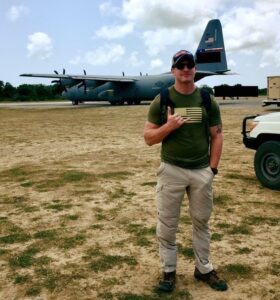
Tom’s job at the JSOC was Airborne Systems Operator. That meant he helped the JSOC conduct intelligence, surveillance, and reconnaissance operations in support of U.S. forces operating in the U.S. Central Command and U.S. Africa Command areas of responsibility. He enjoyed the work and the people he worked with, as they had become tight during the deployment workups and on the deployment itself. Every mission he flew was an adventure.
One opportunity Tom always looked forward to during missions was landing in Somalia to refuel, especially around breakfast. He would contact the air traffic controller ahead of time and ask her to send out food and drinks for the crew while the plane was being serviced. It provided a nice break in the mission, although the heat in the back of plane when it was on the tarmac could be stifling. By the time the plane took off again, every inch of Tom’s clothing would be soaked through with sweat.
In addition to his in-flight responsibilities, Tom served as the team’s driver from the base camp to the airfield, which proved a challenge at first because the Land Rover he drove had a manual transmission. Once he mastered it, though, he enjoyed driving the stick shift. He also learned two important Swahili phrases, “Jambo” and “Asante”, so he could greet and thank the guards at the airfield, which they seemed to appreciate.
During his free time, Tom made an effort to see African wildlife. When he ran by the river near the base camp, the area would be filled with baboons. He had been told not to make eye contact with them or they might attack, so he looked toward the sky whenever they came near. Occasionally he and his buddies drove out in the bush to what had been a watering hole for hippos before it dried up. When they drove by villages, local kids would run after the Land Rover hoping some candy or trinkets might be tossed their way. Tom also bought some handmade souvenirs from a local woodcarver, including a giraffe for his mother, an elephant, and a short staff with an intricately carved lion’s head.
When the nine-month deployment came to an end, Tom and the rest of the members of the JSOC retraced their steps to the United States, flying back on the Navy “rotator” flight from Addis Ababa to Baltimore via a number of regularly scheduled intermediate stops. He was excited to get home to see his family, but soon his life fell back into his pre-deployment routine, now made more boring since he’d experienced the adrenaline and camaraderie of a deployment with special operations forces.
As soon as Tom started drilling again with his Reserve unit at the NOSC in Buffalo, he let everyone know he wanted to transition from the Reserve to the active Navy so he could do other than odd jobs hoping something good would come along. His unit heard his request and got him one-year active duty orders to the Navy Information Operations Command (NIOC) in Hawaii. The orders were perfect because the NIOC needed a CTT, although they involved a relatively quick turnaround after Tom’s return from Djibouti.
Tom reported to NIOC Hawaii, located onboard Joint Base Pearl Harbor-Hickam, in September 2018. He was assigned to the Cryptologic Direct Support Element, focusing primarily on electronic signals intelligence. This meant he helped interpret information gained from electronic signals emitted from things like radars, weapons systems, and aircraft, although his first three months at the NIOC were devoted to working with the administrative staff trying to fix a pay problem resulting from his transition to active duty. That meant he was in Pearl Harbor on the seventy-seventh anniversary of the attack on Pearl Harbor. He spent the day aboard the USS Arizona Memorial running American flags up and down the staff so they could be used to commemorate the anniversary of the attack.
Once Tom’s pay problem was resolved, he deployed during the first week of January 2020 for six months to Yokosuka, Japan, to work onboard the USS Blue Ridge (LCC-19), the flagship of the three-star admiral commanding the U.S. Seventh Fleet. Tom’s sponsor was a female sailor who picked him up at Tokyo’s Narita International Airport, about a three-hour drive from the Blue Ridge in Yokosuka. They finally arrived onboard the ship late at night, but because Tom was assigned to male berthing, his sponsor could not escort him all the way to the compartment. Instead, she got him close and gave him the directions he needed and then sent him on his way. As he had never been on a ship before, he promptly got lost and wandered around carrying his heavy sea bag until he finally found the right place. Worn out after the long trip, he grabbed an open rack and went to sleep. The next day when the other sailors in the berthing compartment saw Tom had reported onboard, they welcomed him and helped him get acclimated to the ship. Then that night, they took him to the Honcho (“Honch”) bar district of Yokosuka and made sure he had a great time.
Thus began Tom’s time onboard USS Blue Ridge. During the day, he stood watch and familiarized himself with the equipment he would use once the ship got underway. He also ate three meals a day and worked out, and then at night went out to the Honch with his new friends to have some fun. The cycle repeated itself every day until the Blue Ridge finally got underway later in January.
Being the Seventh Fleet’s command ship, the USS Blue Ridge had some wonderful port visits scheduled and Tom looked forward to all of them. However, after the ship made calls in Okinawa, South Korea, and Thailand, COVID-19 hit and the ship’s remaining port calls were cancelled. Instead of visiting exotic ports in the western Pacific, Tom and the rest of the crew at one point spent seventy-two consecutive days at sea without a port call, breaking the ship’s previous record of sixty-four days set in 1972 as American involvement in the Vietnam War drew to a close. For Tom, that meant working seventy-two consecutive days without a break.
One highlight of the cruise occurred when the Blue Ridge crossed the equator. Tom recalls the water being completely still, just like reported by sailors on sailing ships caught in the doldrums. As crossing the equator is a significant milestone in a sailor’s career, the ship held a raucous two-day crossing the line ceremony (much like a fraternity initiation), where uninitiated “pollywogs” like Tom became “trusty shellbacks” after appearing before King Neptune’s court. Tom participated in the ceremony after coming off a twelve-hour overnight watch, so it proved challenging for him to make it all the way through to the end. After the ceremony, Tom received an official certificate signed by King Neptune documenting his trusty shellback status.

The Blue Ridge finally returned to its home port in Yokosuka in June 2020. Since Tom was only assigned to the ship for the deployment, he said goodbye to his friends and returned to NIOC Hawaii at Joint Base Pearl Harbor-Hickam. Now at the end of his one-year NIOC Hawaii active duty assignment, he had to decide what was next. He heard he could be sent to an aircraft carrier for a nine-month deployment, but after having just completed a similar assignment onboard USS Blue Ridge, he was not at all excited about that option. He also learned he had been picked up for conversion to the full-time active duty Navy, so he returned to Buffalo to complete the necessary paperwork and identify his next assignment.
That next assignment turned out to be providing direct signals intelligence support to U.S. submarines, which meant Tom had to report to Pensacola for additional training in January 2021. Although he completed the required training, he did not report for his follow-on assignment because he did not want to be vaccinated for COVID-19. Accordingly, he was assigned to the Region Legal Service Office Southeast Detachment Pensacola Legal Assistance Office, helping Navy attorneys provide legal services like powers of attorney, wills, and notaries to sailors and their families at Naval Air Station Pensacola. Finally, in November 2022, Tom and the Navy parted ways when Tom was discharged with an Honorable Discharge in recognition of his many years of service to the Navy.
After his discharge, Tom returned to Kenmore, New York, where he took a sales job with an industrial supply company. He worked there for about six months until an apprenticeship opportunity opened through IBEW Local 41, offering him the opportunity to become an electrician. Tom jumped at the chance and was accepted in May 2023. He remains in the program today and really enjoys the work. He is looking forward to becoming a fully qualified electrician.
Voices to Veterans is proud to salute CTT2 Thomas Elling, U.S. Navy. Never satisfied to simply mark time, Tom volunteered to deploy twice to the far off reaches of the globe, processing signals intelligence in support of U.S. operating forces. The information he provided helped ensure mission accomplishment and kept U.S. forces ready for any contingency. We thank him for his service and wish him fair winds and following seas.
If you enjoyed Tom’s story, please sign up for the Voices to Veterans Spotlight monthly newsletter by clicking here. Once each month, you’ll receive a new written veteran’s story directly in your mailbox. Best of all, it’s free and you can unsubscribe at any time.

